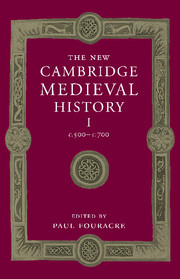Crossref Citations
This Book has been
cited by the following publications. This list is generated based on data provided by Crossref.
Hen, Yitzhak
2009.
A Companion to the Medieval World.
p.
67.
Shanzer, Danuta
2009.
Literature, History, Periodization, and the Pleasures of the Latin Literary History of Late Antiquity.
History Compass,
Vol. 7,
Issue. 3,
p.
917.
GRIG, LUCY
2013.
Cities in the ‘long’ Late Antiquity, 2000–2012 – a survey essay.
Urban History,
Vol. 40,
Issue. 3,
p.
554.
BLAYDES, LISA
and
CHANEY, ERIC
2013.
The Feudal Revolution and Europe's Rise: Political Divergence of the Christian West and the Muslim World before 1500 CE.
American Political Science Review,
Vol. 107,
Issue. 1,
p.
16.
2014.
The Social Life of Hagiography in the Merovingian Kingdom.
p.
33.
Palmer, James T.
2015.
The Otherness of Non-Christians in the Early Middle Ages.
Studies in Church History,
Vol. 51,
Issue. ,
p.
33.
Haldon, John
2015.
Fiscal Regimes and the Political Economy of Premodern States.
p.
345.
McKitterick, Rosamond
2020.
Rome and the Invention of the Papacy.
Vaz-Romero Trueba, Oriol
2022.
Juguetes de madera o el palimpsesto del árbol: vasos mitopoiéticos en las culturas del Mediterráneo antiguo.
Eikon / Imago,
Vol. 11,
Issue. ,
p.
9.
Bosanquet, Antonia Sigrid
2023.
What Should They Do? Depictions of Ribāṭ and Murābiṭūn in Early Islamic Ifrīqiya.
Religions,
Vol. 14,
Issue. 11,
p.
1340.
Fallgren, Jan-Henrik
2024.
Settlement, Climate Crisis and Lordship in Early Medieval Scandinavia.
Current Swedish Archaeology,
Vol. 31,
Issue. ,
p.
143.
Deschepper, Ewoud
De Clercq, Wim
Baeyens, Nathalie
De Mulder, Jelle
Van Thienen, Vince
and
Dekoninck, Michiel
2025.


